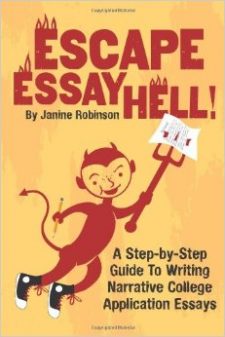Word Counts: Cut it out!
by j9robinson | Aug 13, 2008
Most of the college admissions essays have word count requirements, as do other questions on the applications. Do not ignore them. Stick to their numbers. If it says 500 words, make sure your essay is under that number. If nothing else, it shows you can follow...Need More Help?

As a professional writing coach, I help students, parents, counselors, teachers and others from around the world on these dreaded essays!
Learn about my in-person and online tutoring, editing, workshops, books, and online courses, ... READ MORE....
Online Course
Learn to Write Your Essay in One Hour!

My on-demand, fast-and-easy online e-course: How to Write a College App Essay (Click lightbulb for details.)
Perfect for The Common App, UCs, grad school, transfer and scholarship essays!
Find Helpful Posts!
- About Admissions Officers
- Add a Twist
- Admissions Advice
- Affordability and Success
- Anecdote How-To
- ApplyTexas Essays
- Avoid "English-ese"
- Be Likable
- Beware English teachers
- Brainstorm Guide
- Bump Up a Dull Essay
- Cappex Application essays
- ChatGPT
- Choosing a Topic
- Coalition for Access
- Coalition for Access Essay Strategies
- College Rejection
- Common Application
- Common Prompts
- Commonly Asked Questions
- Conclusions
- Create Pathos
- Creative Writing
- Defining Qualities
- English Teachers Help
- Essay Cheat Sheet
- Essay Contest
- Essay Hell's Writing Guides
- Essay Myths
- Essay Writing Guides
- Essay Writing Training
- FAQ
- Find Core Values
- First drafts
- Grabber Introductions
- Heavenly Essays Book
- Homeschooling
- How Format Common App Essay
- How to Describe a Place/Setting/World
- How to Recycle Essays
- How to Write a Conclusion
- How to Write Short Essays
- International Students
- Ivy League
- Journal Writing
- Jumpstart Essay Experts
- Lesson Plans
- Math and Science Students
- Parents
- Personal Insight Questions
- Personal Statements
- Podcasts
- Resources
- Sample Essays
- Scholarship Essays
- Storytelling
- Supplemental Essay Tips
- Supplements
- Texas Essay Prompts
- The Common App
- Tips
- Title Your Essay
- TMI in Essays
- Top Essay Fears
- Transfer Essays
- Transfer Students
- UC Prompt #1
- UC Prompt #2
- UC Prompts
- UC Transfer Essays
- Uncategorized
- Underprivileged Students
- University of California essays
- University of Colorado Supp
- University of Texas essays
- Video Tutorials
- Waitlist Essays and Letter
- Warning to Top Students
- Webinars
- What Makes a Great Essay?
- When You Are Done
- Where to Start
- Why Essays Matter
- Why Us?
- Word Count
- Writing Advice
- Anecdotes
- Be Specific
- Black and white thinking
- Don't Impress
- Final checklist
- Grabber introductions
- How Find Your Main Point\
- How to Add Depth
- How to add intellectual vitality
- How to Tell a Story
- How to Write an Anecdote
- Ladder of Abstraction
- Mini-Memoirs
- Online course for writing college admissions essays
- Self-editing
- Setting
- Show AND Tell
- Show Don't Tell
- Structure
- Thesaurus
- Tone and Voice
- Universal Truths
- Use Emotion
- Writing Contests



